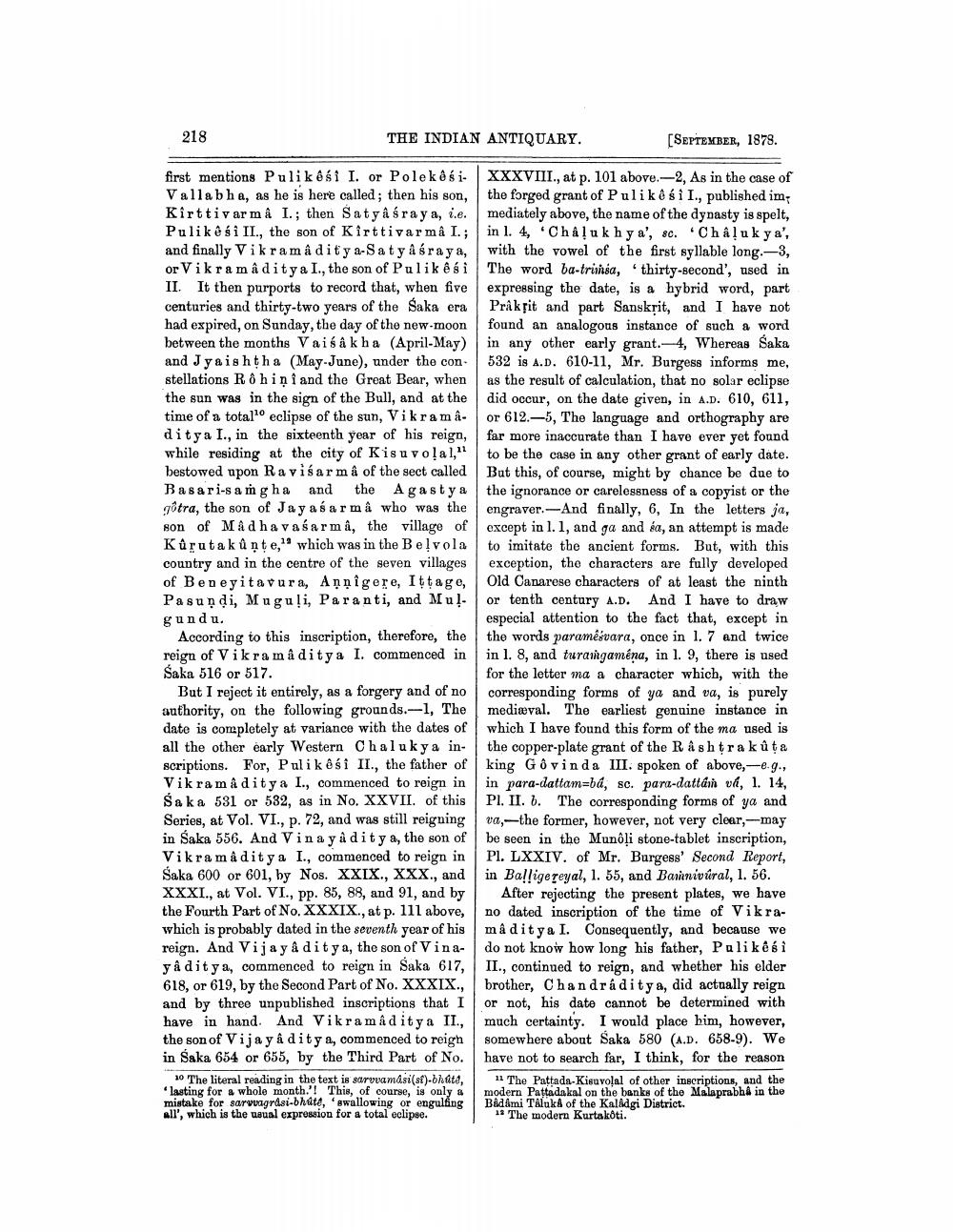________________
218
THE INDIAN ANTIQUARY.
first mentions Pulikêsi I. or PolekêsiVallabha, as he is here called; then his son, Kirttivarma I.; then Satyâśra y a, i.e. Pulikê si II., the son of Kirttivar mâ I.; and finally Vikramaditya-Satyasraya, or Vikramaditya I., the son of Pulikêsi II. It then purports to record that, when five centuries and thirty-two years of the Saka era had expired, on Sunday, the day of the new-moon between the months Vaisakha (April-May) and Jyaishtha (May-June), under the constellations Rô hini and the Great Bear, when the sun was in the sign of the Bull, and at the time of a total1o eclipse of the sun, Vikramâditya I., in the sixteenth year of his reign, while residing at the city of Kisu volal," bestowed upon Ravisarmâ of the sect called Basari-samgha and the Agastya gôtra, the son of Jayasarmâ who was the son of Madhavaśarmâ, the village of Kûrutakûnte," which was in the Belvola country and in the centre of the seven villages of Beneyitavura, Annigere, Iṭṭage, Pasundi, Muguli, Paranti, and Mulgundu.
According to this inscription, therefore, the reign of Vikram â ditya I. commenced in Saka 516 or 517.
But I reject it entirely, as a forgery and of no authority, on the following grounds.-1, The date is completely at variance with the dates of all the other early Western Chalukya inscriptions. For, Pulikêsi II., the father of Vikramaditya I., commenced to reign in Saka 531 or 532, as in No. XXVII. of this Series, at Vol. VI., p. 72, and was still reigning in Saka 556. And Vinayaditya, the son of Vikramaditya I., commenced to reign in Saka 600 or 601, by Nos. XXIX., XXX., and XXXI., at Vol. VI., pp. 85, 88, and 91, and by the Fourth Part of No. XXXIX., at p. 111 above, which is probably dated in the seventh year of his reign. And Vijayâditya, the son of Vinayâditya, commenced to reign in Saka 617, 618, or 619, by the Second Part of No. XXXIX., and by three unpublished inscriptions that I have in hand. And Vikramaditya II., the son of Vijay â dity a, commenced to reign in Saka 654 or 655, by the Third Part of No.
10 The literal reading in the text is sarvvamási (st)-bhaté, 'lasting for a whole month.'! This, of course, is only a mistake for sarvvagrási-bhaté, swallowing or engulfing all', which is the usual expression for a total eclipse.
[SEPTEMBER, 1878.
XXXVIII., at p. 101 above.-2, As in the case of the forged grant of Pulikê si I., published im mediately above, the name of the dynasty is spelt, in l. 4, Châļukhya', sc. Chalukya', with the vowel of the first syllable long.-3, The word ba-trimsa, thirty-second', used in expressing the date, is a hybrid word, part Prakrit and part Sanskrit, and I have not found an analogous instance of such a word in any other early grant.-4, Whereas Saka 532 is A.D. 610-11, Mr. Burgess informs me, as the result of calculation, that no solar eclipse did occur, on the date given, in A.D. 610, 611, or 612.-5, The language and orthography are far more inaccurate than I have ever yet found to be the case in any other grant of early date. But this, of course, might by chance be due to the ignorance or carelessness of a copyist or the engraver.-And finally, 6, In the letters ja, except in 1. 1, and ga and sa, an attempt is made to imitate the ancient forms. But, with this exception, the characters are fully developed Old Canarese characters of at least the ninth or tenth century A.D. And I have to draw especial attention to the fact that, except in the words paramésvara, once in 1. 7 and twice in 1. 8, and turamgamena, in 1. 9, there is used for the letter ma a character which, with the corresponding forms of ya and va, is purely medieval. The earliest genuine instance in which I have found this form of the ma used is the copper-plate grant of the Râshtrakuta king Govinda III. spoken of above,-e.g., in para-dattam-bá, sc. para-dattám vá, 1. 14, Pl. II. b. The corresponding forms of ya and va, the former, however, not very clear,-may be seen in the Munôli stone-tablet inscription, Pl. LXXIV. of Mr. Burgess' Second Report, in Balligereyal, 1. 55, and Bannivúral, 1. 56.
After rejecting the present plates, we have no dated inscription of the time of Vikramâditya I. Consequently, and because we do not know how long his father, Pulikêéi II., continued to reign, and whether his elder brother, Chandraditya, did actually reign or not, his date cannot be determined with much certainty. I would place him, however, somewhere about Saka 580 (A.D. 658-9). We have not to search far, I think, for the reason
11 The Pattada-Kisuvolal of other inscriptions, and the modern Pattadakal on the banks of the Malaprabha in the Bâdâmi Taluk of the Kalâdgi District.
12 The modern Kurtakoti.




